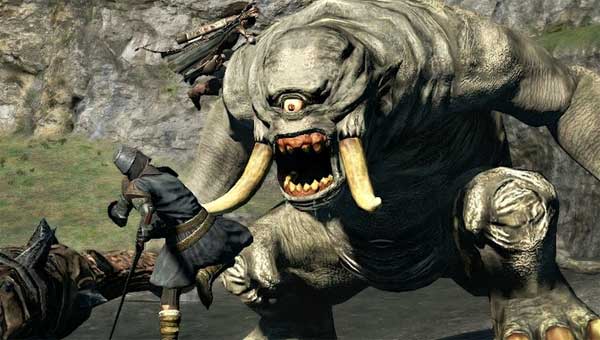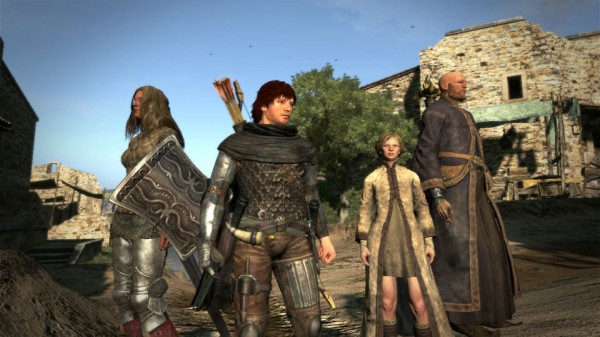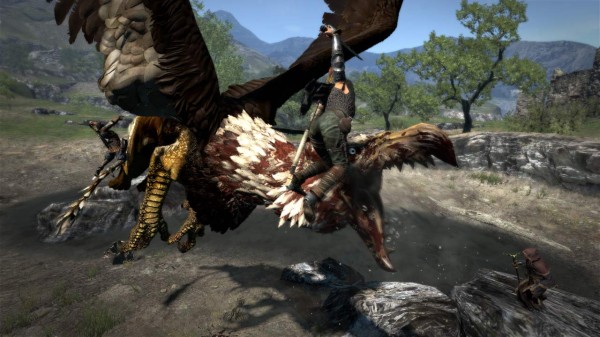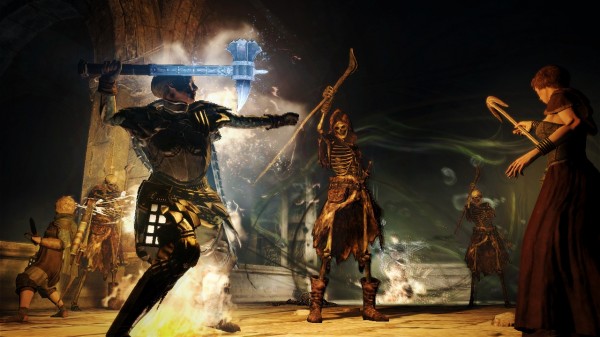Over the past year, a flurry of open-world RPGs have flooded the gaming marketplace. Games like Skyrim— known for its vast world, 200-plus hours of gameplay, and organic storytelling— and Kingdom of Amular: Reckoning— acclaimed for its God of War like combat, colorful landscapes and extensive in-game lore. Capcom’s foray into the genre, Dragon’s Dogma, merges the Japanese developer’s expertise in combat and introduces a robust class and crafting system, with the western mythos and atmosphere of Middle England. The well-orchestrated game mechanics are only undone by a lackluster and predictable story .
In Dragon’s Dogma, a dragon mysteriously appears (literally falls from a hole in the sky) and immediately begins a reign of terror. Players control the Arisen who, after an unsuccessful bout with the beast, is left for dead with a hole where a heart once was. Miraculously the Arisen survives, heartless and ready for a long fight.
Like many open-world games, the lead protagonist is fully customizable. The options are abundant but not overbearing so that every player can create a hero to their taste. For me, Sisqo was the man for the job. At six feet tall, with skin as pure as the darkest chocolate, the build of an Olympic sprinter, and an audacious platinum afro, Sisqo was nothing short of marvelous. The desire to see my character succeed initially hooked into the world; however, that desire was shaken by the average environments and lackluster story.
My biggest qualm with Dragon’s Dogma was the content of the story rather than its execution. The tale of the Arisen is predictable and clichéd. I never felt excited about new plot points, there were never any twists. The game unraveled like an average Dungeon and Dragons novel. It’s a shame because the game encourages players to understand its lore and world through its fluid quest structure and lack of “fast” travel.
Dragon’s Dogma emphasizes exploration and the quests required me to comprehend the world and its inhabitants. Quests are simple enough: fetch a series of items,defeat this monster or a combination of both. Capcom utilized the day cycle mechanic to its fullest, forcing me to consider whether it was best to approach a mission at dusk, midnight or in the early hours of the morning. After the quest, players generally have to walk back to the patron, unless the patron is located in the capital (in which case an item can be used to teleport back). This forced travel allows the player to take in their surrounds and follow the topography of the land. Investigating each river bed, hilltop, and shoreline that is within sight. Unfortunately the terrain I was surveying was a bit dull.
Set in Middle England, the environments never expanded on the source material. The art style did enough so that I could understand its inspiration but not enough for me to be enamored with my surroundings. The capital was a prime example. It was supposed to be the majestic center of civilization but it was not vastly different inside from the first town in the game. It is larger in scale but it felt as populated as the early seaside village. The structures in the capital seemed to be copied from the smaller villages rather than variations on a theme. The stiff artistic style persisted in different aspects of the game.
This problem was also apparent with the NPCs which I felt lacked variation. The soldiers gesture similarly and the women and children wear the same clothes and act as clones of each other. To Capcom’s credit, the NPCs (apart from their appearance) are well-designed. They are always good sources of information. When delivering plot points or miscellaneous information, they are concise and articulate; the voice acting is complementary to the time period. The lack of detail in the art style may have dismayed players but Capcom’s attention to the core game mechanics more than make up for the lapse.
Despite the disappointing story elements, Dragon’s Dogma’s redeems itself with robust combat and crafting systems. Combat in Dragon’s Dogma is addictive. It is the reason to play this game. It’s here that Capcom displays its expertise in action-adventure experiences. When the game begins players selected between three character types: a melee, range or magic fighter. As the game progresses, the system opens up and classes can be combined. Prefer raining down arrows from afar, why not add some flame magic and make the enemies burn to ashes as they charge forward. This mechanic applies to members in a party as well.
As the Arisen, players have the option of utilizing a legion of customizable pawns throughout the journey. Teamwork is essential in Dragon’s Dogma and these mechanics signify that Capcom really wanted players to consider the set up of their team before heading into battle. Dragon’s Dogma isn’t easy and the game punishes unpreparedness, especially during nightfall. At night, the worst of the baddies come out and if players do not seek shelter in an encampment or town, they should prepare for a long terrifying fight.
Crafting offers a unique and sufficiently fun break from battle. There are a multitude of collectables many of which can be combined to enhance weapons and other items. Dragon’s Dogma’s world is vast so exploring the areas to find that specific mine for rare ore or scavenging fields for herbs can break up the intense task of taking down griffins.
Capcom’s open-world RPG isn’t perfect, the story is mundane and the settings leave something to be desired. Nonetheless, the combat is fantastic, crafting is enjoyable and that makes the game fun. Dragon’s Dogma may not be the next genre-defining RPG but it is an undeniably pleasurable experience.






















